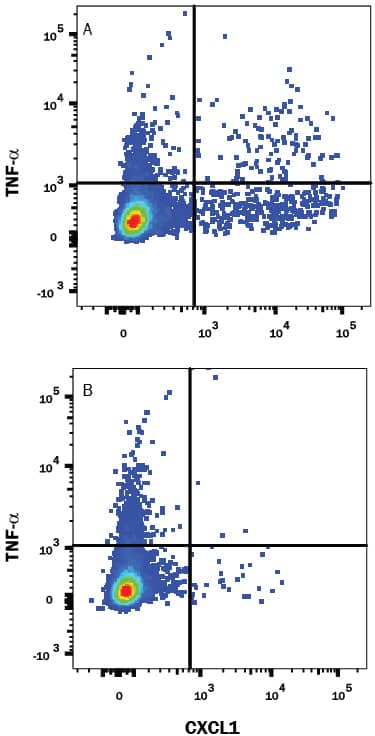Mouse CXCL1/GRO alpha/KC/CINC-1 Antibody
R&D Systems, part of Bio-Techne | Catalog # MAB4532


Key Product Details
Validated by
Species Reactivity
Validated:
Cited:
Applications
Validated:
Cited:
Label
Antibody Source
Product Specifications
Immunogen
Asn29-Lys96
Accession # P12850
Specificity
Clonality
Host
Isotype
Scientific Data Images for Mouse CXCL1/GRO alpha/KC/CINC-1 Antibody
Detection of CXCL1/GRO alpha/KC/CINC-1 in Mouse Splenocytes by Flow Cytometry.
Mouse splenocytes either (A) treated with 1 µg/mL LPS and Brefeldin A for 4 hours or (B) untreated were stained with Rabbit Anti-Mouse CXCL1/GROa/KC/CINC-1 Monoclonal Antibody (Catalog # MAB4532) followed by Phycoerythrin-conjugated Anti-Rabbit IgG Secondary Antibody (Catalog # F0110) and Rat Anti-Mouse TNF-a Fluorescein-conjugated Monoclonal Antibody (Catalog # IC410F). To facilitate intracellular staining, cells were fixed and permeabilized with FlowX FoxP3 Fixation & Permeabilization Buffer Kit (Catalog # FC012).Applications for Mouse CXCL1/GRO alpha/KC/CINC-1 Antibody
Intracellular Staining by Flow Cytometry
Sample: Mouse splenocytes treated with LPS and Brefeldin A were fixed and permeabilized with FlowX FoxP3 Fixation & Permeabilization Buffer Kit (Catalog # FC012).
Reviewed Applications
Read 1 review rated 3 using MAB4532 in the following applications:
Formulation, Preparation, and Storage
Purification
Reconstitution
Formulation
Shipping
Stability & Storage
- 12 months from date of receipt, -20 to -70 °C as supplied.
- 1 month, 2 to 8 °C under sterile conditions after reconstitution.
- 6 months, -20 to -70 °C under sterile conditions after reconstitution.
Background: CXCL1/GRO alpha/KC/CINC-1
KC, a member of the alpha (CXC) chemokine subfamily, was initially identified as an immediate early gene induced in mouse fibroblasts by platelet‑derived growth factor. KC cDNA encodes a 96 amino acid (aa) residue precursor protein with a predicted secretory signal peptide that is removed to yield the mature protein. The protein sequence of mouse KC shows approximately 63% identity to that of mouse MIP-2. KC is also approximately 60% identical to the human GROs. It has been suggested that mouse KC and MIP-2 are the orthologs of the human GROs and rat CINCs. In addition to mouse fibroblasts, KC is expressed in macrophages and endothelial cells. Mouse KC is a potent neutrophil attractant and activator. The functional receptor for KC has been identified as CXCR2. Based on the pattern of KC expression in a number of inflammatory disease models, KC appears to have an important role in inflammation. KC was found to be involved in monocyte arrest on atherosclerotic endothelium and may also play a pathophysiological role in Alzheimer’s disease. Many chemokines are substrates for selective proteolysis at the amino-terminus by various proteases including dipeptidyl peptidase IV or matrix metalloproteases, resulting in truncated chemokine isoforms with different (both enhanced or reduced) bioactivities. The naturally occurring 68 aa N-terminal truncated isoform of mouse KC is reported to be a more potent synergistic growth stimulant for CFU-GM.
Alternate Names
Gene Symbol
UniProt
Additional CXCL1/GRO alpha/KC/CINC-1 Products
Product Documents for Mouse CXCL1/GRO alpha/KC/CINC-1 Antibody
Product Specific Notices for Mouse CXCL1/GRO alpha/KC/CINC-1 Antibody
For research use only